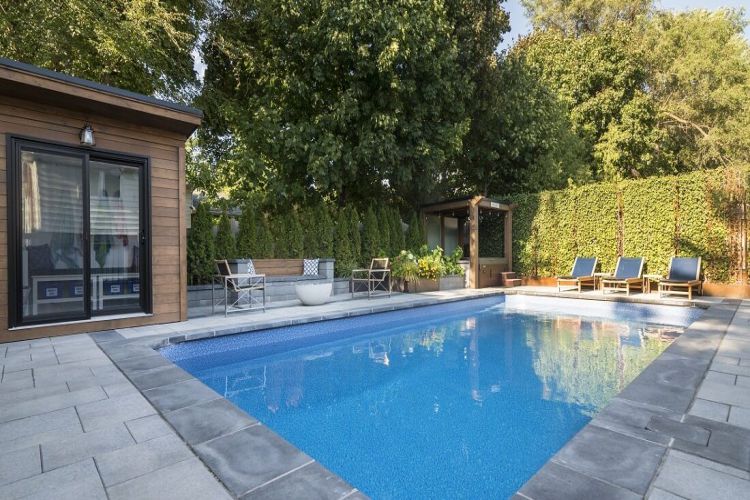 There’s no easier way to ensure your property is classified as a luxury home than to make a pool. However, what if you live in a region with a particularly cold climate? Does this mean that a swimming pool is off the table? Not necessarily!
There’s no easier way to ensure your property is classified as a luxury home than to make a pool. However, what if you live in a region with a particularly cold climate? Does this mean that a swimming pool is off the table? Not necessarily!
Sure, you’ll have to work harder, pay more, and plan more elaborately than if you were building a pool in your Florida home, but it’s still feasible. With that in mind, here are a few tips, tricks, and alternatives to a swimming pool for those living in a cold climate.
1. Build a heated in-ground pool
An in-ground heated pool is probably the first idea that crosses your mind if you’re planning to build a pool in a cold climate area. However, this complex project requires more elaborate planning and a more careful construction process.
The heating system is pivotal in this project, but you must choose the right one. For instance, you could go for a solar heating system, or you could go for gas heaters. This choice will fundamentally change the project at hand.
You must also pay attention to the surrounding landscaping. Just think about it, some plants are accustomed to a certain soil temperature. Your heaters might disrupt this. On the other hand, this means that you may have more tropical plants to consider.
Overall, it’s an expensive and elaborate project but definitely worth it for someone who plans to use it during winter. Sure, if you’re just building your home, remember that this will offset your cost-per-square-foot calculations.
2. Make an indoor pool
The simplest solution for a pool in a cold climate is to make one indoors. This, however, makes things much more expensive since you also need to construct a building around it. This building needs to have suitable heating and other properties.
You will need more space for an equivalent indoor pool, so consult a professional to make a plan. Once you have a plan, you need to get on the task of getting all the permits you need.
Previously, we’ve talked about getting the necessary permits. Some of these are ventilation and heating systems. Without a heating system, even an indoor pool can become inhospitably cold.
Most importantly, you need a decent enclosure. Here, you’ll need to ensure that it has sufficient insulation. Polycarbonate roofs and glass walls are popular choices for a reason. Just remember that none of this comes cheap.
3. Pick the right material for the outdoor pool
If you are dead set on making an outdoor pool (a conventional option) in a region with a colder climate, you must pick the right material. There are really three best options for you here.
Fiberglass: According to veteran pool builders, there’s a rising popularity of fiberglass pools in Minnesota. This is because of the material’s flexibility and resistance to cold weather occurrences. Since the material is non-porous, there’s no risk of water penetrating pores and freezing to cause cracks.
Concrete: This material is durable and can withstand heavy snowfall and freezing temperatures. It retains heat, which means that if you choose to make a heated pool (which we already suggested), this will enhance the effect. They are also quite low maintenance (a big factor in these climates).
Vinyl liner: Similar to fiberglass, vinyl pool liner are non-porous and easy to maintain. Most importantly, they’re resistant to cracking. This ensures that freezing and thawing are not issues.
While the right material doesn’t end all your worries, it’s a great way to make your job easier. If you are to build a swimming pool in these conditions, picking the right material is a must.
4. Consider pool cover
A pool cover can help you maintain the water temperature. This is why you should seriously consider investing in a cover if you plan a swimming pool in a region with a colder climate (at least during one part of the year).
The most common materials for pool covers are either vinyl or mesh. However, you might even choose to install an automatic solid cover for your pool. This is an expensive investment, but it’s the most efficient at keeping your pool safe during winter. It also increases safety for children and pets. Most importantly, it drastically increases the value of the property.
Temperature is not the only problem with the colder part of the year. During this period, debris and leaves are falling, and many similar inconveniences. With a pool cover, you can protect your pool from all that.
Any type of pool cover is a great investment. It doesn’t require additional infrastructure, and it’s nice to have around, even if you don’t use it often.
5. Make a hot tub instead
While we are aware that this was not the original question, the truth is that a hot tub may make more sense. Sure, if you’re looking for a cardio device, a hot tub is not a replacement for a swimming pool.
The problem is that many people say they want a swimming pool but every time they get in, they do two laps and then just chill in the corner. For these people, a hot tub is a better and smarter investment.
First, it’s far more pleasant for colder climates, and it could be a start (and the biggest investment) toward making your at-home spa. It’s also great for those who like running in cold weather to unwind and recover after a particularly long run.
Hot tubs take up less space. This means that you can make them even on your deck. Swimming in cold weather is not a problem; getting to and from the pool gets you. This way, you’re making it closer to home.
Wrap up
Whether you build a pool or an alternative, consider the climate. Once built, the pool is not going anywhere. It will have to endure through cold and warm parts of the year. Also, the maintenance will be a huge issue in its upkeep. Picking a bad choice for your climate will make maintenance harder and more expensive. The more time you spend planning, the more likely you will make the right choice.




